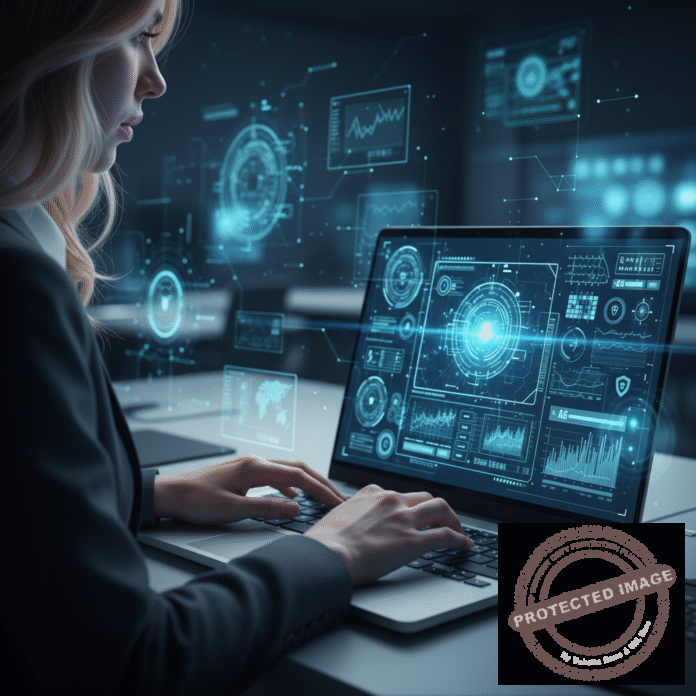“From desktop laptops running inference to edge data-centers and cloud orchestration, hybrid AI architectures are reshaping hardware strategy across servers, workstations and devices.”
The emerging hybrid AI compute paradigm
Traditional AI compute models were heavily cloud-centric: train large models in the cloud, deploy inference back to the device or cloud. However, with increasing demands for real-time decision-making, data privacy, bandwidth constraints, and edge autonomy, hybrid architectures—balancing on-device processing, edge servers and cloud—are rapidly gaining traction. Forbes+2IJSAT
The “edge continuum” concept blends on-device/edge inference with cloud training and orchestration. Latent AI
For hardware strategy, that means: laptops/workstations with NPUs/GPU for local inference, edge servers supporting near-real-time tasks, and cloud/central servers for heavy training, orchestration and model updates.
On-device AI processing (laptops, desktops, workstations)
In laptops and desktops used by knowledge workers, field operations, industrial settings or IoT-connected sites, on-device AI offers:
-
Lower latency (no round-trip to the cloud).
-
Improved privacy (data stays locally).
-
Better reliability under intermittent connection.
From a hardware viewpoint, the key is higher local compute, optimized inference engines (NPUs), supported frameworks and efficient memory/storage for onboard models.
Workstations now are becoming more like “mini-AI data-centres” for mobile or field use: high-performance CPU/GPU + NPU + fast SSD + rich connectivity (5G, WiFi6/7, Thunderbolt).
When advising enterprise clients, you should emphasise: “Does the workstation/laptop support local inference, model updates, secure isolation, and integrate seamlessly with cloud/edge orchestration?”
Edge data-centres and server deployment
Between the device and the cloud lies the edge server or micro data centre. These systems must support: real-time analytics, streaming data processing, orchestration of connected devices, decision-making close to the source, and seamless integration/coordination with cloud. From a hardware viewpoint: GPU/NPU clusters, high-speed interconnect, local storage, and hybrid orchestration software stacks.
Organizations increasingly deploy smaller-footprint server clusters closer to the source of data—this is especially true for industrial IoT, autonomous vehicles, manufacturing hubs, telco/multi-access edge computing (MEC). For such deployments, hardware must handle facility constraints (power, cooling, footprint) and support hybrid compute modes (local + cloud). Research has shown that hybrid architectures significantly improve real-time decision-making performance in hostile/limited-connectivity environments. IJSAT
Integrators should present proposals that include not just cloud-only compute but a hybrid architecture: on-device laptop/workstation + edge server cluster + cloud orchestration node.
Cloud orchestration, training and lifecycle updates
Even in a hybrid model, the cloud remains critical: large-scale model training, model versioning, global orchestration, monitoring, updates, and policy enforcement. Servers in the cloud must integrate with the edge and devices via orchestration frameworks, model deployment pipelines (MLOps), and lifecycle management.
Hardware implications: cloud data-centres must support heterogeneous accelerators (GPUs + NPUs), high-throughput storage and I/O, and optimized networking. From a services viewpoint, this means solutions are more end-to-end: device to edge to cloud. For example: a workstation runs inference locally; if condition X arises, it delegates to the edge server; the edge server coordinates across devices and passes aggregated telemetry to the cloud for model retraining.
This layered compute structure drives hardware procurement across the stack and forces integrators to think in multi-tier terms rather than device-only or cloud-only.
Strategic implications and value for enterprise deployments
-
For enterprise digital specialists (like your role), hardware selection must map to the tiers: device, edge, cloud. Ensure specifications reflect that layering.
-
For clients with hybrid cloud/lakehouse requirements (you’ve flagged interest in hybrid cloud), this architecture dovetails neatly: local processing, edge aggregation, cloud consolidation.
-
For vendors and integrators: value lies in offering full-stack ecosystems that support device + edge + cloud, rather than one-off device purchases.
-
From a competitive perspective, clients that adopt the hybrid architecture now will have lower latency, improved reliability, better privacy, and potentially lower total cost of ownership across their AI stack.
Challenges and caveats
-
Hybrid architectures add complexity: orchestration, update pipelines, model synchronization, lifecycle management across tiers.
-
Security and governance across device/edge/cloud boundaries become more complicated: model versions, access control, data flows.
-
Hardware upgrades at different tiers may not move in sync: e.g., device hardware lags, edge server refresh delays. This can bottleneck performance.
-
Budgeting and procurement often remain siloed (device budget separate from cloud/edge budget), which conflicts with a holistic hybrid strategy.
Closing Thoughts and Looking Forward
Hybrid edge-cloud AI architectures, combining on-device processing on laptops/workstations with server infrastructure at the edge and in the cloud, are firmly emerging as the blueprint for enterprise AI infrastructure. From your vantage point, advising clients or vendors, the message is: don’t purchase in silos—device or “cloud only”. Think end-to-end: Workstations/laptops with NPUs for on-device inference, edge servers with accelerators for real-time local coordination, and cloud servers for heavy training and orchestration. Over the next 2-3 years, expect hardware refresh cycles to align around this layered architecture, and procurement teams to demand visibility into “edge + cloud + device” compute strategies.
Author: Serge Boudreaux – AI Hardware Technologies, Montreal, Quebec
Co-Editor: Peter Jonathan Wilcheck – Miami, Florida
Reference sites
-
“How Hybrid Cloud Is Fundamental For AI-Driven Workloads” — Forbes Councils https://www.forbes.com/councils/forbestechcouncil/2025/11/04/how-hybrid-cloud-is-fundamental-for-ai-driven-workloads/ Forbes
-
“Hybrid AI-Edge Architectures for Mission-Critical Decision Systems” — IJSAT https://www.ijsat.org/papers/2023/4/5505.pdf IJSAT
-
“Architecture Patterns for Edge + Cloud Hybrid AI Systems” — Eureka/Patsnap article https://eureka.patsnap.com/article/architecture-patterns-for-edge–cloud-hybrid-ai-systems Patsnap Eureka
-
“The edge continuum — a new look at the cloud computing role in edge AI” — LatentAI white-paper https://latentai.com/white-paper/ai-edge-continuum/ Latent AI
-
“Artificial Intelligence-Augmented Edge Computing: Architectures …” — IJEI Journal https://ijeijournal.com/papers/Vol14-Issue9/14091827.pdf IJEI Journal
Post Disclaimer
The information provided in our posts or blogs are for educational and informative purposes only. We do not guarantee the accuracy, completeness or suitability of the information. We do not provide financial or investment advice. Readers should always seek professional advice before making any financial or investment decisions based on the information provided in our content. We will not be held responsible for any losses, damages or consequences that may arise from relying on the information provided in our content.



